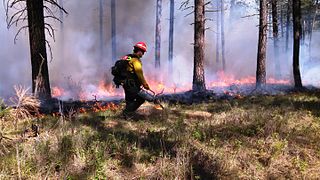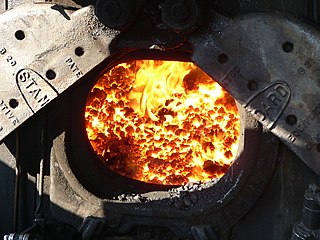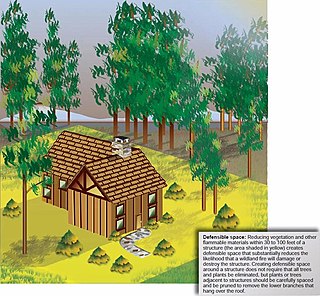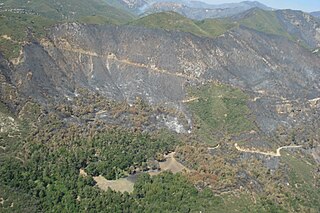Soil retrogression and degradation are two regressive evolution processes associated with the loss of equilibrium of a stable soil. Retrogression is primarily due to soil erosion and corresponds to a phenomenon where succession reverts the land to its natural physical state. Degradation is an evolution, different from natural evolution, related to the local climate and vegetation. It is due to the replacement of primary plant communities by the secondary communities. This replacement modifies the humus composition and amount, and affects the formation of the soil. It is directly related to human activity. Soil degradation may also be viewed as any change or ecological disturbance to the soil perceived to be deleterious or undesirable.

A campfire is a fire at a campsite that provides light and warmth, and heat for cooking. It can also serve as a beacon, and an insect and predator deterrent. Established campgrounds often provide a stone or steel fire ring for safety. Campfires are a popular feature of camping. At summer camps, the word campfire often refers to an event at which there is a fire. Some camps refer to the fire itself as a campfire.

A fire ring is a construction or device used to contain campfires and prevent them from spreading and turning into wildfires.

A campsite or camping pitch is a place used for overnight stay in an outdoor area. In UK English, a campsite is an area, usually divided into a number of pitches, where people can camp overnight using tents, camper vans or caravans; this UK English use of the word is synonymous with the US English expression campground. In American English, the term campsite generally means an area where an individual, family, group, or military unit can pitch a tent or park a camper; a campground may contain many campsites.

Cookware and bakeware are types of food preparation containers, commonly found in a kitchen. Cookware comprises cooking vessels, such as saucepans and frying pans, intended for use on a stove or range cooktop. Bakeware comprises cooking vessels intended for use inside an oven. Some utensils are considered both cookware and bakeware.

Outdoor cooking differs substantially from kitchen-based cooking, the most obvious difference being lack of an easily defined kitchen area. As a result, campers and backpackers have developed a significant body of techniques and specialized equipment for preparing food in outdoors environments. Such techniques have traditionally been associated with nomadic cultures such as the Berbers of North Africa, the Arab Beduins, the Plains Indians and pioneers of North America, and have been carried down to and refined in modern times for use during recreational outdoors pursuits.

Tinder is easily combustible material used to start a fire. Tinder is a finely divided, open material which will begin to glow under a shower of sparks. Air is gently wafted over the glowing tinder until it bursts into flame. The flaming tinder is used to ignite kindling, which in turn is used to ignite the bulk material, to produce a fire.

A controlled or prescribed burn, also known as hazard reduction burning, backfire, swailing, or a burn-off, is a fire set intentionally for purposes of forest management, farming, prairie restoration or greenhouse gas abatement. A controlled burn may also refer to the intentional burning of slash and fuels through burn piles. Fire is a natural part of both forest and grassland ecology and controlled fire can be a tool for foresters.

In a steam engine, the firebox is the area where the fuel is burned, producing heat to boil the water in the boiler. Most are somewhat box-shaped, hence the name. The hot gases generated in the firebox are pulled through a rack of tubes running through the boiler.

Induction cooking is performed using direct induction heating of cooking vessels, rather than relying on indirect radiation, convection, or thermal conduction. Induction cooking allows high power and very rapid increases in temperature to be achieved, and changes in heat settings are instantaneous.

Bioswales are channels designed to concentrate and convey stormwater runoff while removing debris and pollution. Bioswales can also be beneficial in recharging groundwater.
Trekking poles are a common hiking accessory that function to assist walkers with their rhythm and to provide stability on rough terrain.

Heavy-duty cookware made of cast iron is valued for its heat retention, durability, ability to be used at very high temperatures, and non-stick cooking when properly seasoned. Seasoning is also used to protect bare cast iron from rust. Types of cast iron cookware include frying pans, dutch ovens, griddles, waffle irons, flattop grills, panini presses, crepe makers, deep fryers, tetsubin, woks, potjies, and karahi.
Hiking equipment is the equipment taken on outdoor walking trips. Hiking is usually divided into day-hikes and multiple-day hikes, called backpacking, trekking, and walking tours.

A defensible space, in the context of fire control, is a natural and/or landscaped area around a structure that has been maintained and designed to reduce fire danger. The practice is sometimes called firescaping. "Defensible space" is also used in the context of wildfires, especially in the wildland-urban interface (WUI). This defensible space reduces the risk that fire will spread from one area to another, or to a structure, and provides firefighters access and a safer area from which to defend a threatened area. Firefighters sometimes do not attempt to protect structures without adequate defensible space, as it is less safe and less likely to succeed.
A fire regime is the pattern, frequency, and intensity of the bushfires and wildfires that prevail in an area over long periods of time. It is an integral part of fire ecology, and renewal for certain types of ecosystems. A fire regime describes the spatial and temporal patterns and ecosystem impacts of fire on the landscape, and provides an integrative approach to identifying the impacts of fire at an ecosystem or landscape level. If fires are too frequent, plants may be killed before they have matured, or before they have set sufficient seed to ensure population recovery. If fires are too infrequent, plants may mature, senesce, and die without ever releasing their seed.

Backcountry camping food includes ingredients used to prepare food suitable for backcountry camping and backpacking. The foods differ substantially from the ingredients found in a typical home kitchen. The primary differences relate to campers' and backpackers' special needs for foods that have appropriate cooking time, perishability, weight, and nutritional content.

Wildfires are outdoor fires that occur in the wilderness or other vast spaces. Other common names associated with wildfires are brushfire and forest fire. Since wildfires can occur anywhere on the planet, except for Antarctica, they pose a threat to civilizations and wildlife alike. In terms of emergency management, wildfires can be particularly devastating. Given their ability to destroy large areas of entire ecosystems, there must be a contingency plan in effect to be as prepared as possible in case of a wildfire and to be adequately prepared to handle the aftermath of one as well.

Forestry mulching is a land clearing method that uses a single machine to cut, grind, and clear vegetation.

The Indians Fire was a wildfire in the Ventana Wilderness of the Los Padres National Forest in the Santa Lucia Range which that started on June 8, 2008 and burned uncontained until July 10 scorching 81,378 acres (329.33 km2) of land. This fire burned predominately within the Los Padres National Forest, Monterey Ranger District, inside the Ventana Wilderness. Other affected properties include portions of Fort Hunter Liggett military base and private property. The suppression cost exceeded $40.7 million, not including resource damages and rehabilitation costs.
















